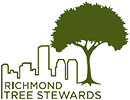Three gravel beds have been constructed by Richmond Tree Steward volunteers for the purpose of growing native trees to be planted in Richmond. The project has come to fruition as part of Tree Stewards’ partnership with Enrichmond and thanks to a grant from the Virginia Department of Forestry for building a demonstration gravel bed.

What’s a gravel bed?
It’s an irrigated bed of gravel in which to place and safely hold bare root or washed containerized tree stock for up to 3-6 months prior to planting. Doing this dramatically increases fibrous root volume and improves the ultimate chances of survival for the plant.
Trees that are bare root may be placed in the gravel bed, or containerized tree stock may be removed from the container, washed of all dirt and then placed in the gravel bed. While in the gravel bed, the trunk, branches and leaves of the tree do not grow any faster or more vigorously than they normally would, however the root system of the tree grows a great deal—and that is the primary goal of the gravel bed—to develop healthy roots systems for trees to be planted in our community. After a few months the original tree develops a healthy ball of fibrous roots and is ready for planting. Its new improved fibrous root system allows for better intake of water and nutrients after the tree is transferred to the permanent planting site.

Here’s why we decided to develop a community gravel bed:
- Improve the plants overall health and survival rate by developing the fibrous root system. This improves plant health and reduces transplant shock.
- Ability to use bare root stock. Bare root stock is generally more available in the spring, but spring is not the best planting season. If we acquire bare root trees in spring and allow them to develop fibrous roots in gravel bed over the summer, they have healthy root systems in the fall—the best planting season.
- Increases species availability. Usually there are more species available for purchase as bare root stock than in containerized or balled and burlap stock. As a result of better diversity, we reduce exposure to insects and disease in our urban forest.
- To save money! Bare root stock costs significantly less than balled and burlap or container trees.
- Labor and cost savings at transplant time. Without the added weight from the root ball we don’t need special equipment for planting.
Trees developed in our gravel bed are planted on Belle Isle in the James River Park System as part of native habitat restoration. We included gravel bed trees in our Community Roots Tree giveaway in 2017 and have scores of seedlings on order for our homeowner giveaway and for restoration planting in 2018.
How we did it…
Richmond Tree Stewards’ Raised Gravel Bed construction is documented in this video:
Another great resource for gravel bed information is from the University of Minnesota Department of Forest Resources available here: All You need To Know About Community Gravel Beds
